Rider Etiquette
Rider Etiquette
Here are some courtesy and safety tips to keep in mind when riding the bus. It takes the cooperation of our bus operators and our customers, to make each ride a safe and enjoyable experience.
Courtesy seating
Passengers using mobility aid devices have priority.
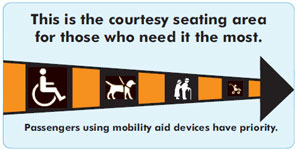 This policy ensures riders keep the front seats open for those who need them the most. The Courtesy Seating Area is intended for passengers with mobility limitations and disabilities, and for seniors.
This policy ensures riders keep the front seats open for those who need them the most. The Courtesy Seating Area is intended for passengers with mobility limitations and disabilities, and for seniors.
Customers using wheelchairs and scooters have priority in the Courtesy Seating Area. All passengers must vacate these seats when wheelchair and scooter users need this space. This designated area is marked on the bus with the logo shown here (above right): If available, passengers with other needs – such as caregivers travelling with a child in a collapsible stroller; pregnant women; and passengers travelling with a collapsible bundle buggy – may use this designated area provided they vacate this space for passengers with mobility limitations and disabilities and seniors.
Passengers using wheelchairs and scooters should board the bus last to allow other passengers to be seated. The bus operator will then secure wheelchairs and scooters in the courtesy seating area.
As a courtesy, please allow seniors and passengers with disabilities to board the bus first.
Strollers/buggies/other bulky items
Strollers, buggies, luggage and other large articles must not obstruct aisles. It is the caregiver's responsibility to secure the child and stroller.
Customers are required to carry on and carry off their own items.
Pet Policy and Service Animals
Pets are permitted to board all buses, however, all pets must be placed in a locked carrier. Pets must be transported in carriers designed for the transportation of animals. The maximum size / dimensions permitted is 28 in L x 20.5 in W x 21.5 in H. Cardboard boxes and cloth bags are not acceptable carriers for animal transportation and are therefore not permitted.
The pet carrier must always be kept with the passenger (on the rider’s lap, under a seat or between a standing rider’s legs) and must not occupy a seat. The carrier must be kept clear of the aisle and doors. Please read our Pet Policy for full details.
Passengers with disabilities using service animals (or a person training a service animal) will continue to access Kingston Transit in the same manner. Service animals are not required to be transported in animal carriers. A service animal is on duty when being used for reasons related to a person's disability.
Smoking
In accordance with the Smoke Free Ontario Act and Smoking Bylaw 2002-231, smoking is prohibited on all transit vehicles, inside bus shelters, and within nine metres of bus shelters located at transfer points.
The use of electronic cigarettes is also prohibited on transit vehicles, inside bus shelters, and within 9 metres of bus shelters located at transfer points.
How to ride the bus
Respect others
Do not use profane or discriminatory language while on the bus.
Respect is a mutual thing. Kingston Transit is committed to providing a safe trip for our riders and a safe working environment for our bus operators. We ask that you treat our bus operators and buses with respect. Our bus operators do their best to ensure that passengers arrive at their destinations safely and on time. However, road construction, inclement weather or traffic congestion may occasionally impact route schedules. Your patience and understanding during these circumstances are appreciated.
Have you had a memorable experience with a bus operator? Let us know by providing operator feedback.
Fare payment & transfers
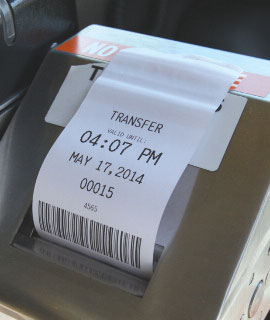 When paying by cash, exact fare is required for depositing into the fare boxes. Only coins are accepted. Bus operators do not carry change.
When paying by cash, exact fare is required for depositing into the fare boxes. Only coins are accepted. Bus operators do not carry change.
Passengers can transfer between routes for free with any fare payment option chosen. Transfers are valid going in one continuous direction from origin to destination within 60 minutes from time of issue.
Riders paying with coins must request a printed paper transfer from the bus operator upon boarding the bus. When boarding the next bus with the transfer, riders must scan the bar code on the printed transfer at the fare box which validates the transfer. Retain your transfer if you need to travel on multiple buses to arrive at your destination. The transfer can be used only by the person to whom it was issued.
Riders using electronic disposable or reloadable smart cards need only to scan their cards at the fare box when boarding. Transfers are automatically stored on the smart cards. The smart technology will identify that you boarded another bus and will not charge your card for another ride.
Bike racks
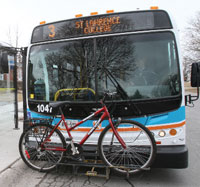 Each Kingston Transit bus is equipped with a bike rack which accommodates two bicycles at any one time. Passengers may secure their bikes for no additional charge. This service is for non-motorized, two-wheel bikes only with wheel diameter between 20 and 29 inches (700c) and a maximum tire width of 2.35 inches. It is the rider's responsibility to load and unload the bicycle from the bike mount. Bike racks are available year round.
Each Kingston Transit bus is equipped with a bike rack which accommodates two bicycles at any one time. Passengers may secure their bikes for no additional charge. This service is for non-motorized, two-wheel bikes only with wheel diameter between 20 and 29 inches (700c) and a maximum tire width of 2.35 inches. It is the rider's responsibility to load and unload the bicycle from the bike mount. Bike racks are available year round.
Behind the line
Stay behind the yellow line so the bus operator has a clear view of the doorway and mirrors.
Hold on
When seats are not available, make sure you hold onto stanchions and straps if you are standing while the bus is in motion. Sudden stops, bumps and jolts do happen so be prepared and be safe.
Don't walk in front of the bus
For your safety, do not walk in front of the bus; wait until it leaves.
Flagging the bus
To ensure the bus operator sees you while waiting for the bus at a bus stop, signal or wave at the Bus Operator that you are waiting for the bus. When it's dark, consider using your cell phone display or flashlight to signal the bus operator.
At major bus stops, more than one bus may arrive at the same time. If the bus approaching is not your bus, take a step back to let the bus operator know that you are not waiting for that bus. Please walk to your bus when it comes to a complete stop.
Express buses do not stop at all bus stops but only at those designated as Express bus stops.
Do not attempt to stop a bus after it has pulled into traffic. Bus operators are not permitted to open doors or allow passengers to board away from bus stops.
Listen for announcements
At different times, the bus operator may make announcements regarding safety, transfer connections, detours and/or regular operations. Listen for these announcements and the automated "next stop" announcements; and be aware of your surroundings and watch for your stop.
Having difficulty hearing an announcement? Report an issue with the announcement system.
Backpacks/totes
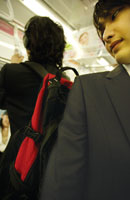 If you carry a backpack or tote, please remove it from your back/shoulder so that when you turn around, you don't injure another rider.
If you carry a backpack or tote, please remove it from your back/shoulder so that when you turn around, you don't injure another rider.
To allow more riders to board the bus: when standing, place your backpack/tote on the floor or in front of you. When seated, place your backpack/tote on your lap.
Backpacks/totes and large parcels should not prevent another rider from being seated.
Cell phone/music
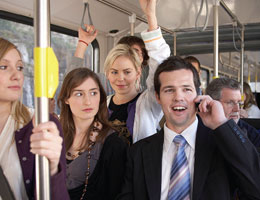 The use of mobile devices is permitted, as long as the user's volume is at an acceptable level and does not disturb other riders or the bus operator.
The use of mobile devices is permitted, as long as the user's volume is at an acceptable level and does not disturb other riders or the bus operator.
Listening to a music device with earphones is permitted. Keep the volume down at an acceptable level to not disturb other riders or the bus operator.
Move to the rear of the bus
When the bus is crowded, please move to the rear of the bus so more passengers can board. We don't want to leave anyone behind.
Request stops for safe arrival
If you ride Kingston Transit regular routes after dark, you can request a stop closer to your destination. Simply tell the bus operator in advance where you wish to disembark and he or she will drop you off as close as safely possible to your final stop, at a point along the established route.
When riding Kingston Express routes, requests are permitted after 8 p.m. at existing marked regular and express stops only along the established route.
As safety is our main concern, lengthy and unnecessary conversations can distract the bus operator and are prohibited.
Use of scented products
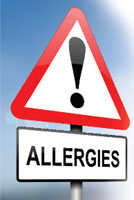 Avoid using scented products as they can aggravate allergies.
Avoid using scented products as they can aggravate allergies.
Clothing
Shirts and footwear must be worn to board the bus or the bus operator will refuse service. If you are coming from the beach or pool, please make sure your clothes are dry when boarding.
Sport gear
Wearing in-line skates, roller blades or ice skates, or use of a skateboard is not permitted on any bus or in bus shelters. You may carry skateboards and skates (with skate guards secured) onto the bus.
Food
Light snacks are permitted, however all food and beverages must be properly contained.
Please take all litter off the bus and dispose responsibly or use the litter bins available where provided on the bus.
Hazardous substances/alcohol
Toxic, flammable or hazardous substances are not permitted on Kingston Transit property – on buses, in bus shelters or at transfer points.
The consumption of alcohol or illegal drugs is not permitted on Kingston Transit property – on buses, in bus shelters or at transfer points.
Lost & found
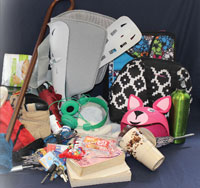 Don't forget your personal belongings when leaving the bus or shelter.
Don't forget your personal belongings when leaving the bus or shelter.
To find out if your article was turned in complete the lost & found form or contact customer service at contactus@cityofkingston.ca / 613-546-0000, Monday to Friday, 8 a.m. to 5 p.m.
Kingston Transit assumes no responsibility for items left behind on the bus or in shelters. Found items are only kept for 30 days.
